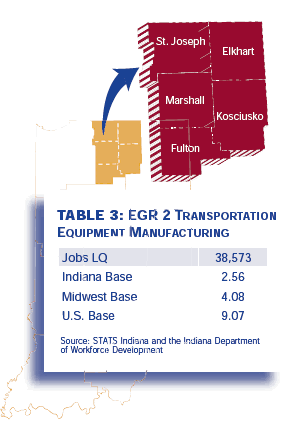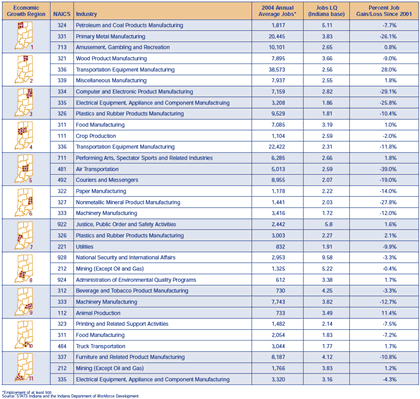Location Quotients: A Tool for Comparing Regional Industry Compositions
Ask the average person on the street to name the Motor City and most will respond "Detroit"—except maybe in Indianapolis. Silicon Valley is recognized as a leader in the production of computer hardware, software and information technology services, while New York City is home to large financial markets. Specializations or concentrations of related industries are a widely recognized economic phenomenon and play an important role in "branding" cities, regions and states. Location quotients (LQ) are used in research to quantify and compare concentrations of industries in a particular area and are critical to understanding an area's economic strengths and weaknesses.
Location Quotients
Location quotients compare an area's business composition to that of a larger area (i.e., nation or state). In order to determine an LQ, a formula similar to the one shown in Table 1 is used.
Table 1: Location Quotient Equation and Rules
An LQ can be calculated for any industry where comparable data exist for both areas. This article discusses regional economies within Indiana and compares the Indiana Department of Workforce Development economic growth regions (EGRs) to Indiana's statewide industry composition.
Location quotients identify export industries in an area (those industries producing more of a good or service than is needed to meet area demand) and import industries (those producing less than enough to meet area demand).
Following accepted economic theory, an LQ greater than 1.0 indicates that an area has proportionately more workers than the larger comparison area employed in a specific industry sector. This implies that an area is producing more of a product or service than is consumed by area residents. The excess is available for export outside the area.
An LQ of at least 1.25 is required to consider classifying an area industry as an exporter. Still, an LQ greater than 1.25 does not necessarily mean that an area industry is exporting; there may simply be excessive local demand.
Identifying area export industries (LQ > 1.25) is useful, as it provides a measure of the degree of industry specialization within an area. A high location quotient in a specific industry may translate into a competitive advantage in that industry for the local economy. Economic development opportunities may exist for additional growth of the exporting or related industries because of the presence of an existing skilled labor pool or other resources such as suppliers, facilities or transportation hubs in the region.
An LQ significantly less than 1.0 may indicate an opportunity to develop businesses in the local area to meet area demand.
Indiana's Regional Industries
Location quotients represent a good starting point for understanding the regional economy and providing information to support regional planning efforts. As expected, different regions of the state have different characteristic industries; but the statewide economy has long been dependent on manufacturing. Despite job losses in this sector in recent years, manufacturing industries appear among the three highest location quotients in 9 of the 11 regions (see Table 2). However, manufacturing industries do not appear among the top three LQs for the Indianapolis area (Region 5). Manufacturing jobs remain a core sector of the region's total employment, but the presence of other industries is significant and diverse when compared to Indiana as a whole.
Table 2: Top 3 Jobs Location Quotients (Indiana Base) by Economic Growth Region, 2004
Two of Region 5's highest location quotients fall into transportation and warehousing (NAICS industry sector 48-49). The region has a high LQ in air transportation (NAICS 481) and couriers and messengers (NAICS 492); air transportation maintains a high LQ of 2.59 despite major job losses in this industry. Both of these industries reflect the region's emphasis on being a distribution hub as the "Crossroads of America."
Another example of a distinguishing industry is arts, entertainment and recreation (NAICS sector 71) for Region 1. The Region 5 economy also exhibits a marked employment concentration in this industry, but these are the only two regions in the state with high LQs for this sector. Region 1 includes Lake and Porter counties, among others, and is partially within the Chicago metro area. Some major cities include Gary, East Chicago and Portage. While the primary metals industry (NAICS 331) is still very important to the region, the concentration in arts, entertainment and recreation reflects the diversification of this economy away from its traditional employment base.
Approximately half of the industries in Indiana's 11 economic growth regions have LQs less than one when compared to the state as a whole. Industries with high LQs do not always employ large numbers of workers, nor do they necessarily display net employment growth. Overall, most regions have not realized positive employment growth within their top three LQ industries. The most significant exception to this is the transportation equipment manufacturing industry in EGR 2 (see Table 3).

Region 2—comprised of Elkhart, Fulton, Kosciusko, Marshall and St. Joseph counties—has an LQ of 2.56 in transportation equipment manufacturing (NAICS 336). This subsector has been driven mainly by the recreational vehicle manufacturing boom in Elkhart County. This concentration is even more pronounced when compared to the Midwest or United States. Region 2 has a 4.08 LQ for this industry compared to the Midwest and an astounding 9.07 when compared to the country as a whole. Other industries that have grown at relatively strong rates include animal production in EGR 9 (11.4 percent) and plastics and rubber manufacturing in EGR 7 (2.1 percent).
In six of the state's EGRs, manufacturing subsectors were listed in the top three LQs twice and captured all three of the top LQs in 3 EGRs. In Economic Growth Regions 2, 3 and 6 the top three industry location quotients were all in manufacturing. In EGR 2, this includes an impressive location quotient of 3.66 for wood product manufacturing (NAICS 321). Only two EGRs had agricultural industries among their top three location quotients: crop production in EGR 4 and animal production in EGR 9. These regions are geographically large and contain significant rural areas.
Geography and available resources may also explain why an industry is prevalent in a given area. Mining (NAICS 212) has a high LQ in both EGRs 8 and 11. These regions are in the southwestern part of Indiana with significant deposits of coal. Coal mining is considered an export industry, meeting the demands of an area beyond the borders of these regions.
Location quotients are especially useful identifying both the distinguishing industries and also the commonalities between regional economies. They confirm the intuitively obvious (e.g. southwest Indiana's coal mining concentration) and help tease out emerging trends as economies change, grow and diversify (such as the development of the arts, entertainment and recreation industry in northwest Indiana). Location quotients are an excellent tool for economic and workforce development planners to use in recruiting prospective employers to areas that have concentrations of workers with transferable skills and other key resources, or in directing them to areas where local demand is exceeding current supply of a product or service.
Charles Baer and Terry Brown
Advanced Economic and
Market Analysis Group, Strategic Research and Development, Indiana Department
of Workforce Development


